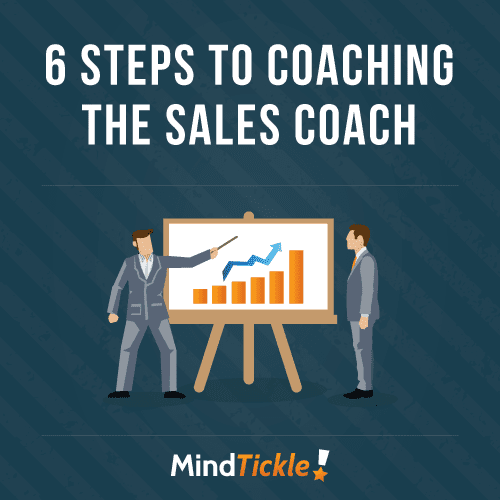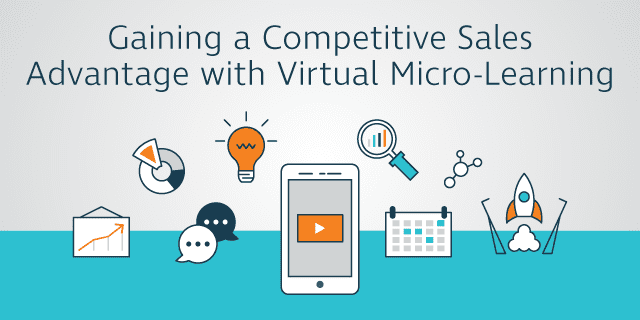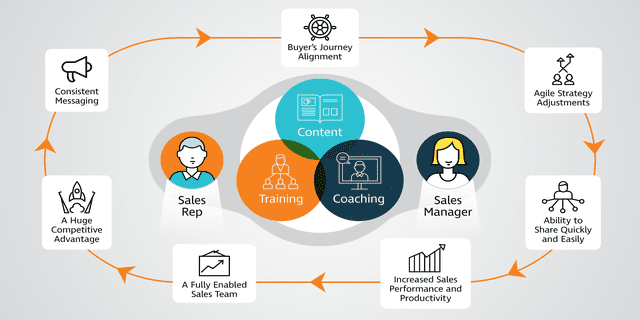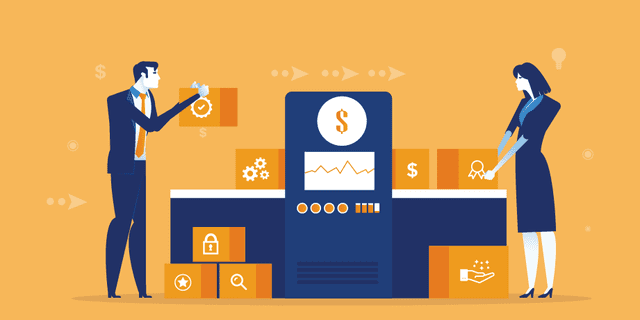6 Reasons Your Managers Need Sales Leadership Coaching


We know that sales coaching is an important part of sales management. It helps your reps become better salespeople overall, improves their skills, increases their engagement with your organization and, of course, improves your topline revenue. Studies have found that effective sales coaching programs can improve sales reps’ performance by up to 20%. But many managers actually don’t know how to coach well. Despite their abundance of experience as a rep, the promotion to a management role doesn’t always come hand-in-hand with specialized training.
Effective sales coaching isn’t about occasionally auditing your reps’ activities, or giving some in-person feedback every once in a while, but about building a regular cadence to provide useful, insightful and specific coaching in areas where individual reps need help. After all, coaching sales reps can be tricky for management because each individual has unique areas that they excel and others where they need extra guidance.
Here’s the thing: Sales Development Reps (SDRs) are one of the fastest growing teams inside B2B sales organizations. But when you look at some of the data about these specialized sellers you find out that over 80% of them have less than 2 years of experience and their average tenure at companies is 1.5 years, according to the Bridge Group.
This presents a few challenges for sales managers. First, very inexperienced sales hires require a lot of information about industry, processes, methodologies and overall basic sales knowledge than your tenured salesperson, and their short tenures mean you will be constantly onboarding new sales development reps which may strain your onboarding program but most importantly, you need to ensure extremely short ramp times.
To best enable the SDR team you have to think of your enablement program as more than just onboarding. Having a great sales onboarding program is great and the best way to ensure quick success for the SDR but think of it more holistically including:
- Ongoing knowledge reinforcement
- Experiential training and practicing
- Coaching and career development
For example, if your rep has five areas where they need coaching, how do you know if their sales managers can address every single one? And how do you prepare your managers to find these gaps in the first place? Perhaps they’re great at pipeline management but struggle when it comes to deal coaching.
Given the breadth of the role of sales manager, it’s simply not possible for them to know how to coach sales reps on everything. But, just like their reps, they need sales leadership coaching so they can fill their own gaps.
Look in the “too hard” basket
Another issue that all sales leaders deal with at one point or another is “avoidance”. If something is difficult to do, or someone simply doesn’t know where to start, it’s much easier to put it in the “too hard” basket and forget about it until something bad happens.
Trying to coach sales reps only in adversity, like when they’ve just lost a big deal, is hard for both the manager and the rep. After all, no one wants attention just because they haven’t done their best, and coaching isn’t about yelling at someone for not performing. It’s about encouraging and developing reps to be their best.
That’s why it’s sales leadership coaching is so necessary; it’s important to ensure sales managers are coached to provide their teams with the skills and behaviors they need, proactively rather than reactively.
So what exactly is sales leadership coaching?
Before we get into the detail of how to help your sales managers learn how to coach their reps, it’s important to differentiate between coaching, training, and managing.
- Management is about overseeing things and making sure they stay on track.
- Training focuses on learning new knowledge.
- Coaching is about developing skills, improving performance and/or changing behaviors.
Sales coaching is the ongoing, one-on-one mentorship of each rep on a sales team. It is a conversation between the rep and a coach, where the rep does most of the talking while the coach listens, observes, and offers feedback.
It’s not about telling someone what to do, but about helping them look at different ways to achieve better results. When done well, sales coaching can drive sales’ productivity and effectiveness.
1. Develop a coaching framework
The first step in helping managers learn how to become an effective sales coach is to develop a sales coaching framework. But beware, there is no one-size-fits-all solution because every business is different. To work out what your coaching framework should include why not ask your sales reps what they need. Speak to your sales managers to find out what they would find useful, and ask your executives about the overall objectives.
This information can then be used to build your aX + bY + cZ formula for effective sales coaching. This framework is tailored to your organization’s needs while ensuring you cover the necessary aspects of sales coaching including knowledge, messaging, sales skills, process, and execution rigor and discipline. While no sales coaching program will be identical, it’s critical that each ensures that managers have:
- The knowledge required to coach in all the areas
- The skills to actually coach
- The tools required to build a cadence for coaching
- The discipline to execute the coaching framework consistently
2. Put the sales coach into training
Once you’ve identified the key areas that your salespeople need coaching, you’ll need to identify whether your managers have the requisite skills. The best way to ensure managers have the knowledge and skills to coach is to provide them with formal training. There are many ways this can be done, from formal in-class training to peer to peer learning.
Football coaches have to be certified before they get to coach players. In fact, the process for certifying a football coach is thorough, with several levels, depending on the experience of the coach and the level of the players they seek to coach. It should be the same for sales coaches.
One of the most effective ways to coach is to give both the reps and their managers the same information and knowledge and make sure they are certified in key areas. This ensures they have the same baseline knowledge, and the certification ensures they have absorbed the information and are able to apply it.
For example, one of our customers, a high growth tech company was launching a new product and wanted to ensure their sales team delivered a consistent message to prospects. To enable their sales managers to coach sales reps through this they first certified them on how to sell the product themselves. This ensured that they knew exactly what the reps had to do, and when combined with their own experience and skills were prepared to coach their teams effectively.
When this approach is complemented by guidance on how to coach, it can be powerful.
Provide live examples to managers on how to have coaching conversations. Help them understand what they should be looking for and what areas to focus in on for the greatest impact. Provide them with the opportunity to role-play their coaching so they can play it back and learn from it.
3. Leverage reporting and tools
All the training and practicing in the world won’t be of any use to a sales manager if they’re going into their coaching sessions blind. That’s where good reporting on the right things is critical. When determining what they should be coaching sales reps on, most managers just look at lagging indicators like pipeline activity and what deals reps have won or lost. But this doesn’t always provide enough useful data. That’s where efficiency and capability indicators are important.
While effectiveness indicators look at the behaviors that sales reps can demonstrate to drive lagging indicators. Coaching is about behaviors, not quotas, this qualitative information needs to be available to managers so they know what to coach on.
This information can be identified by bringing together information from several places, whether it’s from a CRM, sales enablement software or competitive intel. The key is giving managers the tools that can help them identify which indicators to look at and access to get the right information.
For example, if you’re looking at what the indicators are for salespeople who win deals, your sales enablement software can provide you with information on what content your best reps are accessing before a big meeting. This may provide data about what behaviors are correlative with winning deals, and in turn what behaviors may need to change in order to improve the results of some of your reps.
With useful data-driven reports in hand, managers are able to identify what specific areas individual reps require coaching in, and start working on improving their behaviors and results.
4. Mentor the coach
With the right tools, your sales managers will be much better equipped to coach. But they will still need to learn how to use tools to achieve the best effect. One of the best ways to learn coaching is to learn from peers. Your sales reps buddy up, so why not “buddy up” your sales managers? With role models to help mentor and demonstrate good practice, managers will be able to ask questions and share their knowledge with their peers.
While mentoring and buddying is usually a one-on-one activity, you can encourage collaboration and peer-to-peer learning amongst the management team by bringing them together. Some of our customers have organized manager workshops that give sales managers the opportunity to share what works and what doesn’t in a supportive and collaborative environment.
It’s also a great idea to encourage managers to share their coaching wins with the entire sales team. This has a dual impact for allowing the sales organization to learn from what works, and also demonstrates the value of coaching to any skeptics.
5. Provide regular feedback from executives
If your organization has a sales coaching culture then your sales leadership will want to know how your sales managers are performing. Rather than observing from afar, they should be encouraged to see how managers are coaching regularly and provide their own feedback and insight to the team or when appropriate, even individuals. By getting involved they can demonstrate just how important the sales coaching program is to the success of their sales team, and in doing so, boost engagement in the process.
6. Incentivize successful coaches
Along with executive buy-in, rewards and incentives are another good way to engage sales managers. While successful sales managers are incentivized when their team meets quota, how often are good sales coaches recognized or incentivized?
Consider adding in a coaching specific incentive to your KPIs for encouragement for those who learn how to coach well. When used as part of a structured coaching program, these six steps will ensure that you give your sales managers the knowledge, skills, and discipline to coach consistently.
Concluding thoughts
Ultimately, more than helping SDRs craft an email or hone their pitch, sales enablement training for a manager can help them coach their reps based on the competency model that was developed (or recruit the managers to help craft it). Part of the problem most companies face is not giving good guidance for managers on what to coach their teams on and ensuring all managers are consistently coaching their teams on an ongoing basis. While this can be tricky to implement initially, some organizations turn to Coaching Reports in the form of an Excel file, Word document or similar which although well-intentioned end up being a burden for the managers and makes it difficult for the enablement team when it comes time to compile information and glean insights from it.
Finally, technology here can help as well. With the ability to create electronic coaching forms that follow a competency profile and different online forms for different coaching situations you can ensure managers are all following the same guidance and the data collected can be analyzed and shared back with the managers to show them how their teams are doing in their expected competencies as well as guide the managers to where more coaching is needed.
The ultimate takeaway here is that it’s extremely important to treat your sales manager training differently from all others –making sure to tailor each program to the needs of your particular reps based on their experience, tenure, and skill level will help your managers’ coaching significantly both in the short and the long run.













